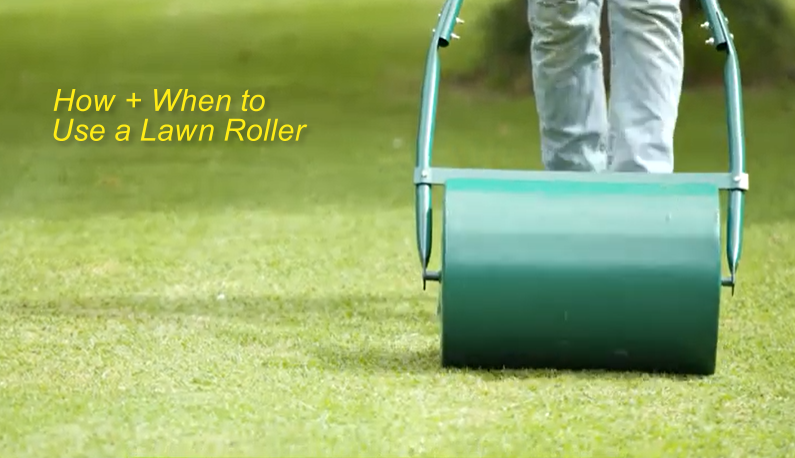A lawn roller is a very useful tool for lawn maintenance. The heavy cylinder attached to an axle is usually pulled over the lawn to flatten out bumpy spots. It can also be used when seeding a new lawn, for pressing grass seed into the topsoil for perfect germination.
The equipment can either be pulled manually by hand or towed by a tractor in large gardens. Lawn rollers are either made of steel or polyurethane.
Steel Lawn rollers are heavier, and more durable and range from 24 to 60 inches. Being heavy makes them more stable, and also, they cannot puncture easily. They are usually filled with water to make them weighty.
Poly lawn rollers on the other hand are lighter and cheaper compared to steel lawn rollers. Their sizes range from 24 – 48 inches. They can be filled with both sand and water.
However, they are not very durable as they are vulnerable to punctures and cracks. Their light weight makes them easier to use and store when empty as you can hang them in the garage.
Although a lawn roller is an essential tool for your lawn, it should be used in moderation. Frequent use of the lawn roller can compact the topsoil, making it difficult for the grassroots to get water and nutrients.
Nutrient and water deficiency will cause the grass to thin and eventually dry.

When to Use Lawn Roller
Rolling the lawn at the wrong time can cause damages that might take too long to repair. The best time to roll a lawn is during spring when the grass is coming out of dormancy, and the roots are actively growing.
You should not use a lawn roller when the soil is wet because the soil will get compacted. Roll when the soil is dry or damp. For the same reason, use a lightweight lawn roller when rolling a grass lawn.
Rolling a yard once a year is enough. However, you may need to use a lawn roller when:
1. Seeding a new lawn
After tilling the ground, spreading the grass seed, and covering them with soil, you can use a lawn roller to press the seed into the soil. This helps the seed germinate faster and eliminates the possibility of it being washed away or blown away by the wind.
2. Repairing a lawn
A lawn roller is helpful when leveling a bumpy lawn. If your yard has molehills or other bumps then you can use a lawn roller to flatten them. A bumpy lawn is unappealing and can trap water, which is unhealthy for grass.
3. Before Sodding
It is important to roll the soil before sodding because installing sod works better on flat soil. Rolling compacts the soil and creates a strong base for the sod.
4. After Sodding
After laying the sod, apply water then roll the lawn to press the sod roots into the soil. Watering the sod before rolling softens the soil and prevents the grass from getting damaged.
How to Use a Lawn Roller
There are two types of lawn rollers. There is the manual lawn roller that needs a human to pull. It is lightweight and cheaper but effective for smaller yards.
The other type of lawn roller is attached to a tractor to pull. It is heavy and expensive but ideal for bigger gardens. Using the manual lawn roller for a bigger garden is labor-intensive and will take a long time to finish the task.
Here is how you use a lawn roller
- Assemble the lawn roller – use the manufacturer’s instructions in the user manual to assemble.
- Fill in the lawn roller with water or sand – a steel lawn roller should be filled with water, while a poly lawn roller should be filled with water and sand.
- If planting grass seeds or sodding, till the lawn and remove all weeds and stones, then fertilize the soil.
- When planting grass seeds – Spread the grass seeds and rake the soil to cover the seeds. Then roll the soil and sprinkle some water afterward.
- When sodding – Roll the soil before laying the sod. After laying the sod, water the sod till the soil gets damp (not wet). Then roll the sod to press the roots into the soil.
- Rolling an already established lawn – Simply move the roller over the lawn to flatten any lumps. Fill any holes with topsoil and continue rolling to achieve an even surface.
What Lawn Roller Alternative Can I Use?
Frequent use of a lawn roller will cause stress to your grass by compacting the soil resulting in the grass thinning and dead patches. It is not recommended to roll a lawn more than once a year unless it is completely necessary.
Buying a lawn roller is unnecessary for most people since they can only use it once a year and it’s quite pricey. The majority of people will prefer to lease or use the following alternatives:
- Plywood – Put the plywood on the new lawn and walk on it to press the sod into the soil. It works better and faster if two or more people walk on it.
- Use a power rake to flatten bumps on the lawn during seeding. First, you need to do core aeration to reduce soil compaction, and then rake the lawn to level bumps. Spread the seeds and use the rake to cover the seeds with soil. Afterward, water the soil to encourage germination.
- Other alternatives for a lawn roller include a landplane, a tiller and harrow, an asphalt roller, a drag broom, and a bobcat.
Conclusion
Rolling your yard will help flatten the lumps and give it a uniform look. However, you should roll the lawn cautiously as it can cause soil compaction. You should limit rolling the yard to once a year unless you are planting new grass seeds or sodding.